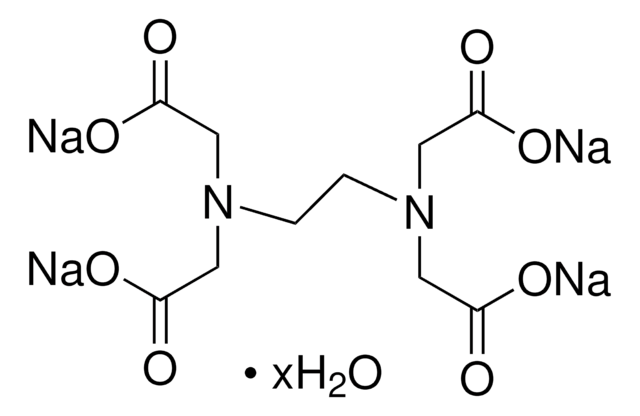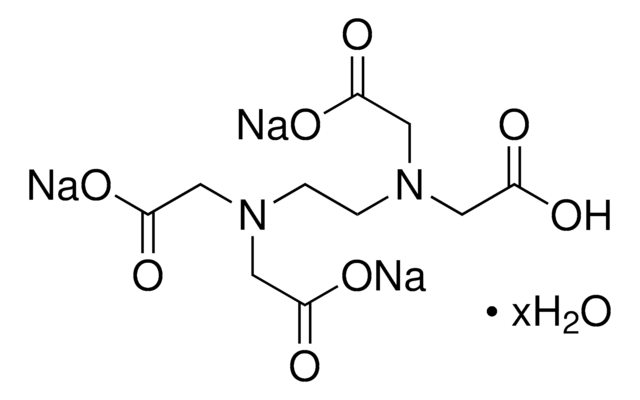ED4SS
Ethylenediaminetetraacetic acid tetrasodium salt dihydrate
99.0-102.0% (titration)
Sinónimos:
EDTA tetrasodium salt, Edathamil, Tetrasodium ethylenediaminetetraacetate dihydrate
About This Item
Productos recomendados
assay
99.0-102.0% (titration)
form
crystalline
reaction suitability
reagent type: chelator
solubility
H2O: soluble, clear, colorless
SMILES string
O.O.[Na+].[Na+].[Na+].[Na+].[O-]C(=O)CN(CCN(CC([O-])=O)CC([O-])=O)CC([O-])=O
InChI
1S/C10H16N2O8.4Na.2H2O/c13-7(14)3-11(4-8(15)16)1-2-12(5-9(17)18)6-10(19)20;;;;;;/h1-6H2,(H,13,14)(H,15,16)(H,17,18)(H,19,20);;;;;2*1H2/q;4*+1;;/p-4
InChI key
KSYNLCYTMRMCGG-UHFFFAOYSA-J
¿Está buscando productos similares? Visita Guía de comparación de productos
Categorías relacionadas
General description
Application
- in the decalcification of femurs for the histoprocessing and staining of osteochondral tissue
- as a component of NH4Cl lysis buffer for erythrocyte lysis and bulk characterization
- for the isolation of crypts from the connective tissues of mice
Biochem/physiol Actions
Related product
signalword
Danger
hcodes
Hazard Classifications
Acute Tox. 4 Inhalation - Acute Tox. 4 Oral - Eye Dam. 1 - STOT RE 2
target_organs
Respiratory Tract
Storage Class
11 - Combustible Solids
wgk_germany
WGK 2
flash_point_f
Not applicable
flash_point_c
Not applicable
ppe
dust mask type N95 (US), Eyeshields, Gloves
Elija entre una de las versiones más recientes:
¿Ya tiene este producto?
Encuentre la documentación para los productos que ha comprado recientemente en la Biblioteca de documentos.
Los clientes también vieron
Artículos
Enzymatic Assay of Cathepsin B
Protocolos
Enzymatic Assay of α-Glucosidase by the Modified Boehenger Procedure (EC 3.2.1.20)
Recycling Micro-Assay of β-NAD and β-NADH
Enzymatic assay of lipase type XIII from Pseudomonas sp. using a coupled enzyme system of glycerol kinase and glycerophosphate oxidase (EC 3.1.1.3)
This procedure may be used for all Ficin products.
Nuestro equipo de científicos tiene experiencia en todas las áreas de investigación: Ciencias de la vida, Ciencia de los materiales, Síntesis química, Cromatografía, Analítica y muchas otras.
Póngase en contacto con el Servicio técnico









